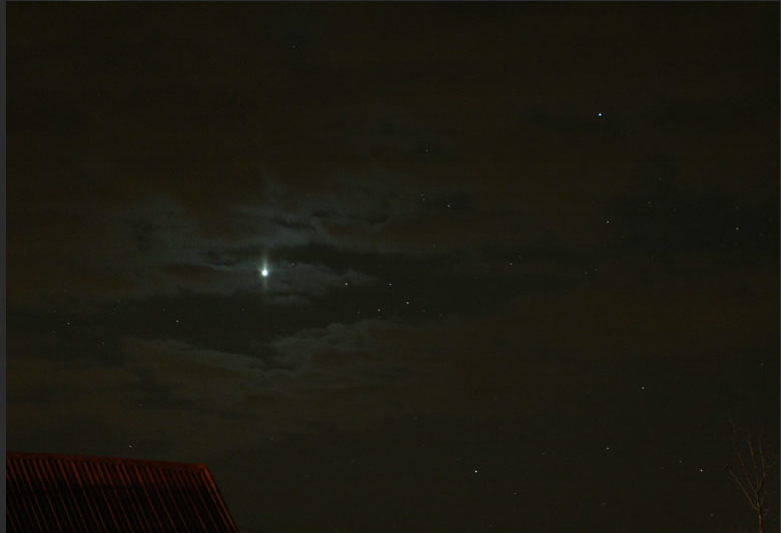Corona: Moon & Venus
Corona: Moon & Venus
When it comes to atmospheric optics, there are a multitude of fascinating phenomena that can occur. One such phenomenon is the occurrence of a corona around celestial objects like the Moon and Venus. While corona formations are commonly observed around the Sun, witnessing them around other celestial bodies is quite rare and captivating.
Recently, an intriguing example of this optical effect was captured by Ernő Berkó in Hungary. On February 15th, Berkó managed to photograph a stunning Venusian Pillar, which showcased the corona formation around Venus itself. This phenomenon is quite unique, as pillars can typically be seen above and below any bright light source. In this case, Venus provided just the right amount of brightness to produce these rare pillars.
To capture this ethereal sight, Berkó utilized a Canon 350D camera with a 70mm f2.8 lens, using a 10-second exposure. The resulting image, presented without any enhancements, beautifully displays the upper and lower pillars surrounding Venus. Each pillar measures approximately 0.4° in length, which is roughly equivalent to the width of a thumb at arm's length.
The mesmerizing pillars are created by cloud plate-shaped ice crystals present in the atmosphere. These ice crystals reflect the light emitted by Venus off their large hexagonal faces towards the observer and the camera. Rather than being vertical shafts of light, the pillars are formed by the collective glints of numerous crystals, resulting in their stunning appearance.
This extraordinary optical phenomenon serves as a reminder of the intricate interplay between light and atmospheric conditions. It is a testament to the wonders that can be witnessed when nature aligns just right. While corona formations around celestial bodies other than the Sun may be rare, they offer a captivating glimpse into the complexity of our atmosphere.
The rarity of observing such phenomena makes each sighting all the more special. These unique occurrences provide scientists and enthusiasts with valuable insights into the behavior of light and the atmospheric conditions that contribute to these optical effects. By studying and documenting these events, researchers can deepen their understanding of the Earth's atmosphere and its interaction with celestial objects.
It is worth noting that the image accompanying this article was taken by Ernő Berkó himself, and it serves as a testament to his skill in capturing such a remarkable event. His photograph beautifully showcases the Venusian Pillar, highlighting the intricate details of the corona formation around Venus.
In conclusion, the corona formation observed around celestial bodies like the Moon and Venus is a rare and captivating phenomenon. The recent sighting of a Venusian Pillar captured by Ernő Berkó in Hungary provides a stunning example of this optical effect. The pillars, formed by cloud plate-shaped ice crystals reflecting the light from Venus, create a mesmerizing spectacle in the night sky. These occurrences offer valuable insights into the behavior of light and the intricate workings of our atmosphere. Each sighting serves as a reminder of the complex interplay between celestial objects and the atmospheric conditions that shape our world.

Venusian Pillar Another Hungarian optical effect (1,2,3). Imaged by Erno Berk� at Ludanyhalaszi , February 15th. Image ©Ernő Berkó shown with permission.
Pillars can in principle be seen above and below any light source provided it is bright enough. Venus just meets that requirement and here produces rare pillars.
Ernő used a 10s exposure with a Canon 350D and 70mm f2.8 lens. The image is as taken with no enhancement.
The upper and lower pillars are short but nonetheless impressive. Each was about 0.4° long and would be covered by the width of a thumb at arms length.
Cloud plate-shaped ice crystals produced the pillars by reflecting the light from Venus off their large hexagonal faces towards the eye and camera. The pillars are the collective glints of may crystals rather than vertical shafts of light.
Note: this article has been automatically converted from the old site and may not appear as intended. You can find the original article here.
Reference Atmospheric Optics
If you use any of the definitions, information, or data presented on Atmospheric Optics, please copy the link or reference below to properly credit us as the reference source. Thank you!
-
<a href="https://atoptics.co.uk/blog/corona-moon-venus-2/">Corona: Moon & Venus</a>
-
"Corona: Moon & Venus". Atmospheric Optics. Accessed on November 26, 2024. https://atoptics.co.uk/blog/corona-moon-venus-2/.
-
"Corona: Moon & Venus". Atmospheric Optics, https://atoptics.co.uk/blog/corona-moon-venus-2/. Accessed 26 November, 2024
-
Corona: Moon & Venus. Atmospheric Optics. Retrieved from https://atoptics.co.uk/blog/corona-moon-venus-2/.